Seville, Spain is a great destination for solo travel and backpackers. Despite the city’s huge popularity among tourists, it is still a place worth visiting for those who like to lose the crowds and wander alone.
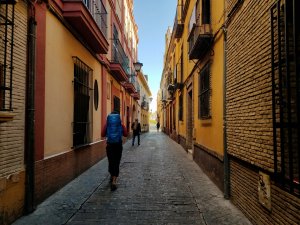
In between touring the highlights of Seville, it’s easy to lose the crowds of tourists and find a more authentic side to the city. There are attractions in Seville even the most pretentious backpacker should see, but there is also a lot more to experience beyond the long lines and group tours.
**This page may contain affiliate links. The Hangry Backpacker may receive a small commission from any purchases made through these links at NO ADDITIONAL COST to you. All products are personally used by the Hangry Backpacker and help to support continued content, here.
This guide is written by a backpacker for any traveler that wants to make the most of a trip to Seville, be that other backpackers, solo travelers, couples or simply someone who wants to escape the restrictions of their group for a day. Here is everything you need to know about visiting Seville, Spain:
Contents
Solo Travel in Seville – Exploring the Highlights
Solo travel is a great way to explore Seville. There’s something about wandering around by yourself, caught up in a crowd, only to escape to silence moments later on a tiny backstreet.
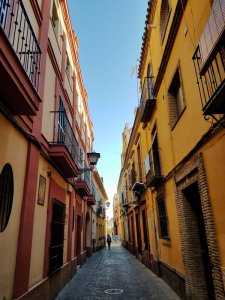 Of course, having a companion or photographer is convenient, but Seville is perfect for backpacking and solo travel. All of the tourist highlights are fine by yourself, and, after sightseeing, it will make it easier to immerse oneself in the local culture. By that, yes, I mean tapas and beer.
Of course, having a companion or photographer is convenient, but Seville is perfect for backpacking and solo travel. All of the tourist highlights are fine by yourself, and, after sightseeing, it will make it easier to immerse oneself in the local culture. By that, yes, I mean tapas and beer.
Seville Cathedral
The Cathedral of Seville is the most famous landmark in the city. The cathedral is notoriously massive. Officially named Cathedral of Saint Mary of the See (Anglicized), Seville Cathedral is one of the largest churches in the world.
The church dominates the surrounding scene and dwarfs nearby buildings. The structure is visible from afar and the nearly-350-foot tower remains the second-tallest structure in Seville.
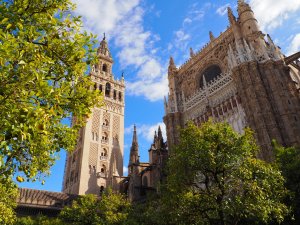
The Cathedral of Seville is a must-visit for a trip to Seville. It is an excellent example of the history of Andalusia. Seville Cathedral was originally a mosque before it was expanded after the Spanish Reconquista. Seville’s history is evident in the cathedral’s obvious Spanish elements along with Moorish features. The tower, for instance, has its origin as a minaret.
The history of Seville Cathedral is interesting, but practical information for visitors is important, too. For tourists, the cathedral is open almost every day with limited hours on Sundays and Mondays. A proper tour should take 1-2 hours depending on your level of interest.
For more specific information and details, read the Hangry Backpacker’s Guide to Visiting Seville Cathedral.
Plaza de Espana of Seville
The Plaza de Espana of Seville is one of the most spectacular buildings in all of Spain. The enormous, crescent-shaped structure is a blend of various architectures from Spanish history come to fruition in one place.
Visiting the Plaza de Espana is pretty straightforward. It is located in the middle of Maria Luisa Park. The famous plaza is noteworthy for its beauty and use in movies (Star Wars; Lawrence of Arabia). More significantly, it is known as a symbol of Seville, Andalusia and all of Spain.
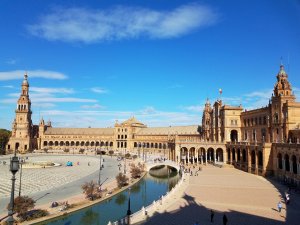
The Plaza de Espana of Seville is not a museum or anything like that. It is simply a beautiful building. Aside from the local justice department housed inside one small section, most of the building is just there to be seen. Visitors can walk through a semi-circular veranda that wraps all the way around the front of the structure, and there are two balconies open for an additional perspective.
Plaza de Espana of Seville is a magnet for photographers. The grandeur and detail of this building is remarkable.

Unfortunately – and laughably, I should add – Plaza de Espana attracts those attention-starved, wannabe Instafamous types. I seriously saw a person toting a rolling suitcase full of different outfits. With a tripod set up, she would change outfits every few minutes and continue the photoshoot. I also saw another group of three tourists doing the same thing. Uhh, what? I couldn’t help but laugh and roll my eyes.
There are plenty of others at Plaza de Espana trying to capture their breakthrough Instagram post. I’m not sure they realize how ridiculous they look. Clearly, I’m not a fan of this type of travel. This is a fascinating place, and it’s disappointing to see travelers (anywhere) so distracted by vanity that they’re missing the world around them.
Tourists are interesting people to watch. As a backpacker looking for free entertainment in Seville, go to Plaza de Espana and people watch. On my next visit, I’m bringing the goods for a picnic. Yes, it’s cheesy (pun intended), but it’s a fun way to spend an afternoon in Seville.
Alcazar of Seville
The Alcazar of Seville is the former royal palace built after Christian kings regained control of the city. The interior of the palace is pretty impressive in its design. It features multiple styles that were prominent in Seville, combining Spanish and Moorish elements.
The Alcazar of Seville is popular with tourists, but, in my opinion, it is overpriced. It costs nearly 20€ for basic entrance plus access to the royal bedroom. Why pay extra to see part of the Alcazar that is less impressive than the Nasrid Palaces in Granada? Backpackers and budget travelers in Seville can better spend that money by exploring the fantastic local cuisine.
Torre del Oro
The Torre del Oro is an old watchtower that sits on the bank of the river. The tower dates back to the 1200s and the days or Moorish Spain.

Today, the Torre del Oro is a landmark. It is the most recognizable feature on the river in Seville. The moorish design stands out in Seville, which is dominated by picture-perfect Andalusian scenes.
Torre del Oro is open to the public. Tickets cost up to 3€ for admission. Admission to Seville’s second-most famous tower is free on Monday. However, it may be best to fork up that 3€. Mondays can be very busy.
Get Lost in Old Sevilla
Perhaps the most alluring attraction of solo travel in Seville is the city itself. The Cathedral, dominating the surrounding scene and the skyline from afar, is the shining beacon. Plaza de Espana is a marvelous sight to behold. But the streets of Seville and the colorful buildings that line these streets are why travelers fall in love with Andalusia.
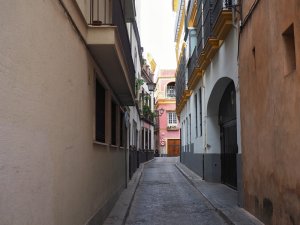
This central area of Seville is Casco Antiguo. This area includes most of the tourist highlights (in Centro and Santa Cruz) and the largest crowds. The crowds are unavoidable, but it’s not too difficult to get lost around here. Casco Antiguo is the old part of the city, where the streets are narrow and in disarray. It’s an absolute joy to wander.
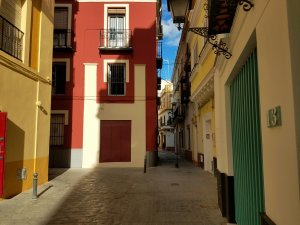
Seville is very popular with tourists, but this is no reason for backpackers and solo travelers hoping to lose the crowds to stay away. Seville is one of these places where it’s popular for a reason. Simply put, it’s cool. Despite the tourists, it’s easy to get lost. It’s easy to lose track of time, and taking a detour at every crossroad is as tempting as the last.

Wandering the winding streets of Seville is like stepping onto a film set. That feeling is probably the inspiration behind so many famous films and works of literature using Seville as a setting.
The most popular streets to stroll in Seville are those in the city center. Yes, this is where most of the tourists congregate, but it is very easy to leave the tour groups behind.
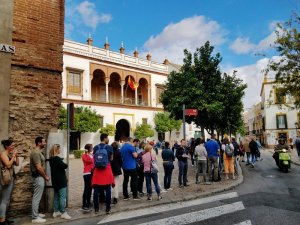
Backpackers and solo travelers in Seville only need to walk a few blocks from the major tourist sites. A short walk leads to the beautiful scenes for which the city is known. Tour groups in Seville don’t stray far, so pick a direction and go. Better yet, pick a neighborhood and wander for the entire day. Getting lost is the most enjoyable part of solo travel in Seville.
Explore Triana & Los Remedios
Seville’s large size makes it a great destination for solo travel. Most tourists won’t linger far from the main sights. After checking these off the list, explore the other side of the river.
The west side of the Guadalquivir River is home to a more local, authentic side of Seville. There are no big hotels or tour groups. This part of Seville is not on many itineraries. The neighborhoods (districts) of Triana and Los Remedios are predominantly local and free of tourist crowds.
Triana is an old neighborhood. It still has the charming architecture in touristy Seville, with old buildings, narrow streets and tiny plazas hiding around the corner. The difference is Triana isn’t crawling with tourists.
My favorite part about Triana is the abundance of restaurants and bars. Tiny bodegas are on every street and every corner. These are the best places to go for a local vibe in Seville.
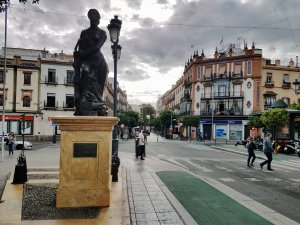
One such area is Plazuela de Santa Ana, a small square in front of a church. There are a few local restaurants with tables outside in the square. Plazuela de Santa Ana is a calm area. It is functionally a neighborhood hangout, making it the perfect spot to experience the local atmosphere of Seville.
Los Remedios is adjacent to (south of) Triana. Los Remedios has more commercial activities and shopping, but it is another great area to escape tourist crowds and experience the real Seville.
Locals shop and eat in Los Remedios. The streets are a little wider, and the buildings are a little newer. Don’t let that deter you from exploring this neighborhood. I ate in Los Remedios a few times. The food was cheaper than Santa Cruz, and the staff at these places was incredibly welcoming.
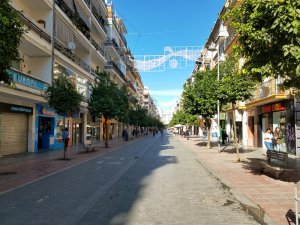
For my fellow backpackers, solo travelers and other tourists in Seville seeking an authentic piece of the city – and, perhaps, seeking to leave the crowds far behind – try to explore beyond the city center. Santa Cruz, San Bernardo and Casco Antiguo are great areas to wander, but there is so much more to this city.
Most tourists barely make it past the first block or two of the bridge over the Guadalquivir RIver, if they even make it that far. This is a different side of Seville that is only a short walk from the main sights. Triana and Los Remedios are excellent options to spend a day exploring a more authentic side of Seville.
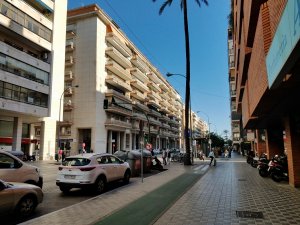
I traveled to Seville to eat, see the main sights and hopefully explore an authentic side of the city. The benefit of backpacking in Spain, of solo travel in Seville, is the freedom to wander beyond the tourist trail and leave the crowds behind. The streets of Seville are the perfect place to do that.
Bullfighting in Seville
Bullfighting is a famous, albeit controversial, pastime in Spain. Some places in Spain, notably Catalonia, have outlawed bullfighting. Bullfighting is still popular in Andalusia, and Seville has a large arena that is sure to be an exciting experience.
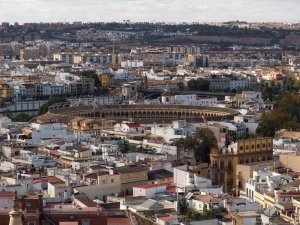
For squeamish backpackers in Seville, a bullfight may not be the best activity. Otherwise, bullfighting in Spain is considered to be a form of art, and, historically, many matadors have turned their art into wealth and fame. Proponents of bullfighting in Spain argue for the cultural importance of the events and that these bulls live much longer, happier lives than typical farm animals.
The Plaza del Toros in Seville is a place to check out even for travelers that don’t want to see a fight in action. The building is beautiful, and there is an interesting museum on site, as well.
Bullfighting season in Seville runs from early Spring until September or October. The biggest events of the year take place during the April Festival (more below).
Flamenco
Seville is the capital of flamenco in Spain. The traditional music and dance of flamenco is synonymous with Spain, and that tradition began in Seville.
For tourists, there are several flamenco shows each night in various locations around the city. Most of these take place in the more touristy area of Seville. Local flamenco shows in Seville are less frequent than performances staged for tourists but can still be found.
Local flamenco productions will likely be smaller, more intimate events than tourist shows. To find one of these more authentic experiences, ask the staff at your hostel or hotel. To fully immerse yourself in Seville culture, find a local flamenco show. Triana has multiple small venues for the real experience.
Roman Seville
The history of Seville goes back thousands of years. That history, especially the mark left on Seville by the Roman Empire, is still visible today. Roman ruins in Seville include remains of an aqueduct, columns, an amphitheatre and more.

For history enthusiasts, there are ruins beneath the Metropol Parasol (Setas de Seville), which are open to visitors for a fee. The aqueduct and columns sit in public spaces, so all you have to do is walk.
Roman ruins outside of Seville are more extensive than those within the city. The amphitheatre of Italica is just a few miles outside Seville. It is very much in ruins, but this is surprisingly interesting compared to the well-preserved and restored ruins elsewhere in Europe. For more extensive Roman ruins, check out the town of Carmona about an hour by bus from Seville.
The Archives of the Indies
During the 1500s, Seville was the economic center of Spain. The once-glorious and busy port of Seville was the landing point for gold, silver, spices, crops and much more. Seville was rich. Really rich.
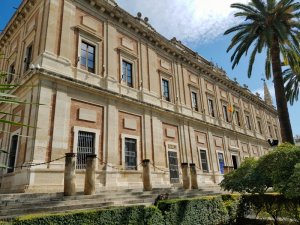
As the Spanish headquarters for activities in the New World, a lot of cool stuff – and an abundance of damning information, no doubt – wound up in Seville. For the historical significance, the Archives of the Americas is a really interesting idea for visitors in Seville. However, unless you’re a scholar with weeks to spend going through fragile documents, the Archives of the Indies, unfortunately, is not worth too much time.
There is some cool stuff in the Archives, but solo travel and backpacking in Seville is better spent eating and exploring. Take a photo. Say “wow.” Go eat.
Eating & Drinking in Seville
Seville has fantastic food. Much like in Granada, the culture of tapas is strong in Seville. It is different than in Granada, but a fun and tasty way to explore the city nonetheless.
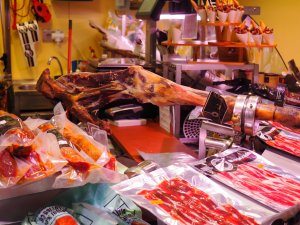

Food in Seville is unique. There are Spanish, Andalusian and local elements of the cuisine. Solo travel in Seville is rewarded by the casual nature of many restaurants. Backpackers in Seville will find comfort in the overall affordability of food. Restaurants and bars primarily have standard Spanish beers, and wine-lovers will find joy in the famous wine.
Other than to say it’s great, eating in Seville cannot be simply covered in a few sentences. For in-depth information, read the Hangry Backpacker’s Guide to Eating & Drinking in Seville.
Best Viewpoints in Seville
Finding viewpoints is an important part of travel. For practical purposes, it helps travelers get their bearings in an unfamiliar destination. For more enjoyable reasons, there’s just something cool about a good view. Seville is an old city, and there aren’t that many tall buildings. Most structures don’t rise more than a few stories. There are a few places to find an excellent view in Seville, though:
El Giralda
El Giralda is the minaret-turned-bell-tower of Seville Cathedral. The whole of Seville Cathedral is magnificent, but the tower is the clear highlight.
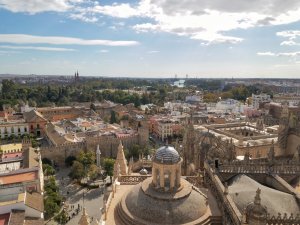
Access to El Giralda is included in the ticket price to Seville Cathedral. From the top, there are great views of Santa Cruz, Casco Antiguo, the surprisingly-impressive roof of the cathedral and the squares immediately below. The various embrasures and windows along the way to the top also have good views.
There is no elevator or escalator to the top of El Giralda. There are 34 ramps, but don’t worry. The climb to the top is not as daunting as it sounds.
Sevilla Tower
The most obvious choice for a great view in Seville is Sevilla Tower. This is the tall tower visible in the distance. Although shrouded in controversy – many locals consider this skyscraper as nothing more than an eyesore – Sevilla Tower is the tallest building around.
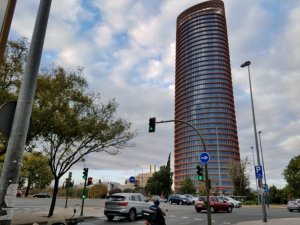
Sevilla Tower, also known as Cajasol Tower and Torre Pelli, is about 600 feet tall. In addition to a hotel, the skyscraper has an observation deck. At this height, this is the most comprehensive view of Seville. Cost is 5€ to the top. The best part of the observation deck at Sevilla Tower is that you don’t have to see the building itself because, in truth, it is kind of an ugly building.
Torre del Oro
Torre del Oro, the famous riverside tower in Seville, is another viewpoint to explore in Seville. The views from Torre de Oro are the best of the Guadalquivir River, the bridges and the neighborhood of Triana.
There is a small museum inside the tower. The tower isn’t very large, so it can be busy and crowded. The top of Torre del Oro also has good views of Seville Cathedral. Tickets are 3€.
Metropol Parasol
The Metropol Parasol is an interesting structure. Surrounded by the beautiful buildings of old Seville, this peculiar wooden structure dominates the scene. Metropol Parasol is more commonly called Setas de Sevilla, which literally means “mushrooms of Seville.”
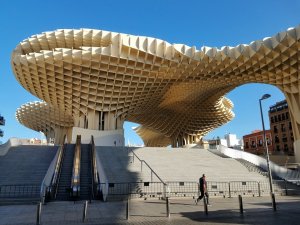
Like other modern buildings in Seville, Metropol Parasol is controversial. The controversy stems from the design, which obviously does not match the neighborhood. However, further controversy exists because the structure cost OVER 100 million euros. That’s a lot of money to spend on giant wooden mushrooms for a place with economic troubles.
Personally, the controversy of this thing is the claim that it is the world’s largest wooden structure. Perhaps that is technically true, but I don’t think you should be able to claim something held together by metal plates, metal bolts and metal cables as the largest wooden anything.
Controversy and frivolous spending aside, Setas de Seville is actually kind of cool. Initial instinct is that this ginormous perforated mushroom is ridiculous and does not belong. After some reflection, strangely, it works. Setas de Seville is neat.
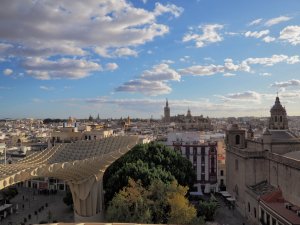
The view from the Metropol Parasol is a good one. It costs 3€ to get to the top. There isn’t much at the top other than a pathway, but there are good views of the city and, of course, Seville Cathedral. The weird, wooden waste of money is a fun place to visit in Seville.
Notable Hostels
Seville is a great city for solo travel, backpackers and budget travelers. In addition to the large, expensive hotels, Seville has some really good hostels.
- slightly more expensive than others, but a great central location and a lively atmosphere
Triana Backpackers Hostel
- nice, clean, quiet
- best part is that it’s in Triana, giving guests the perfect opportunity to explore Seville beyond the tourist center
- great info and local knowledge from staff
Hostel One Catedral
- great location with great rooftop view
- free dinner, great way to meet other travelers
- good choice for those seeking a fun hostel
For You Hostel
- one of the most popular hostels in Seville
- very clean, good privacy, bathrooms in each room
Transportation in Seville
Walking & Biking in Seville
Getting around Seville is easy. The city is pretty flat and walking is the most practical method of transportation. The only downside to walking in Seville is the heat during Summer months. Yes, it gets hot, but it’s not Bangkok hot.
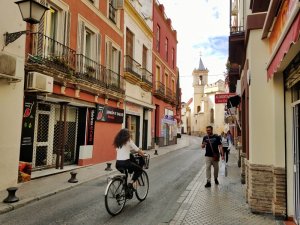
Walking is the best way to get around Seville for solo travel, backpackers, budget travelers and health-conscious individuals. All of the main tourist points of interest are within walking distance of one another. For more curious travelers wishing to explore further into the city, walking is still the easiest choice.
Bicycling is more common in Seville than in any other Spanish city I have yet to experience. Many roads have bike lanes, and the generally flat terrain also makes biking a more attractive option. Biking is practical for solo travel in Seville, but the city isn’t quite suitable for biking en masse.
Public Transportation in Seville
Seville has an extensive bus system. The city bus is cheap and easy to use. Bus lines even extend from Seville to other nearby towns, which is a bonus for backpacker budgets considering day trips.
Seville also has a single-line metro system. The metro costs up to €3 for a trip. This is not to be confused with the tram that runs in the city center. Currently, the metro is of little use to tourists. The tram is utterly useless, however, it is supposed to connect to Santa Justa station at some point in 2020.
National & International Transportation
Santa Justa is the main train station in Seville. If you’re making the more-tedious-than-necessary journey from Granada, this is where the train arrives. For visitors en route to/from Madrid, Santa Justa is the station where that train departs/arrives.
The high-speed train to/from Madrid, the AVE train, is comfortable and easy. Unfortunately, the short journey is expensive. Tickets are cheaper if bought in advance. Prices change daily, but I recommend buying tickets as soon as possible.
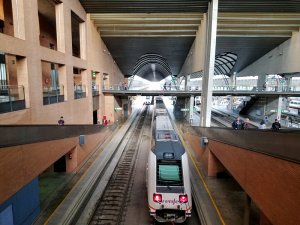
Other trains from Santa Justa can take travelers to Barcelona, Cordoba, Cadiz and more. Please note, though, any high-speed or AVE trains will be expensive even for short distances.
Bus is usually the cheapest intercity travel option. It may be uncomfortable, but buses from Seville travel to destinations all across Spain. Internationally, there are buses to Lisbon. Flixbus is a cheap and easy bus option.
For air travel, Seville’s airport is best for budget airlines and medium-distance flights. In a quick search, I found several one-way flights from Seville airport to Morocco, London and other near-ish destinations for less than $40 USD. Flying overseas from the Seville airport will likely be expensive.
Other Seville Tips
Siesta
Yep, Seville is one of those places in Spain where the siesta is still very much a thing. Personally, I don’t get it. The fat ass in me loves the idea, but, in practice, it seems incredibly lethargic and counterproductive.
Regardless of my thoughts on siestas, this is an important thing to plan for in Seville. If you’re planning to be away from the touristy areas in the middle of the day, be aware that many shops, restaurants and bars close for a few hours in the late afternoon.
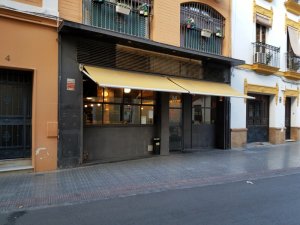
As implied, businesses in the touristy areas of Seville keep more regular hours. Elsewhere, I suggest packing a snack or plan to do something outside. Or, of course, you can always join in on the siesta.
Semana Santa
Holy Week in Seville, Semana Santa, is a huge religious festival during Easter week. During Holy Week in Seville, each parish parades statues and relics – full disclosure: I’m not a Catholic, so the intricacies of this festival escape my knowledge and interest. Despite my ignorance to the details and inner workings of Semana Santa, there are travel implications to consider.
The streets of Seville are packed during Holy Week. The festival, from what I understand, is elaborate and busy, yet solemn and reverent. Holy Week in Seville is surely a spectacle to witness.
For tourists, especially for solo travel in Seville, this is not the best time to visit unless you’re a religious pilgrim. Streets are full of people. Museums and restaurants close or alter hours. Budget travelers and backpackers in Seville will also have difficulty finding affordable accommodation during Holy Week.
April Fair
The April Fair is the biggest party of the year in Seville. It is also another busy time in the city. The festival takes place after Semana Santa, so it’s not always in April. Local women wear super fancy dresses. There are famous bull fights, parties, horses and so on.
The April Fair is surely a fantastic event, but it is not of much use to tourists. Much of the event space, in striped tents, is open only to individuals with invitations, and it’s not the sort of event where you can buy your way in or pay someone at a hotel to make it happen.
There are some tents open to the public, but without an invitation, the April Fair is another time when travel will be difficult in Seville for tourists. If you have the connection to procure an invitation, make it happen.
Solo travel and backpacking are the best ways to explore Seville, Spain. This vibrant culture of Andalusia comes to a head in Seville, and getting lost on the narrow, winding backstreets is the best way to experience the city.
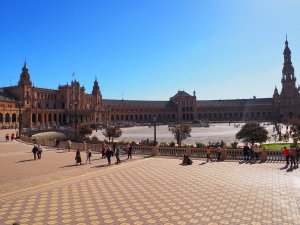
For every historic, picturesque reason to visit Seville, there is a tasty and fun reason to match. Don’t let the popularity and tourist crowds keep you away. After checking the highlights off the list, it’s easy to avoid tourist crowds and wander deeper into the city. And then, backpackers, solo travelers and all other visitors can get the full experience of Seville.

Leave a Reply
You must be logged in to post a comment.